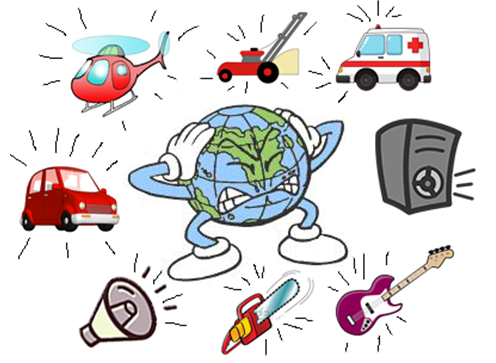Noise Pollution – Environment Notes – For W.B.C.S. Examination.
শব্দ দূষণ – পরিবেশের নোট – WBCS পরীক্ষা।
Noise pollution, unwanted or excessive sound that can have deleterious effects on human health and environmental quality. Noise pollution is commonly generated inside many industrial facilities and some other workplaces, but it also comes from highway, railway, and airplane traffic and from outdoor construction activities.Continue Reading Noise Pollution – Environment Notes – For W.B.C.S. Examination.
Measuring And Perceiving Loudness
Sound waves are vibrations of air molecules carried from a noise source to the ear. Sound is typically described in terms of the loudness (amplitude) and the pitch (frequency) of the wave. Loudness (also called sound pressure level, or SPL) is measured in logarithmic units called decibels (dB). The normal human ear can detect sounds that range between 0 dB (hearing threshold) and about 140 dB, with sounds between 120dB and 140 dB causing pain (pain threshold). The ambient SPL in a library is about 35 dB, while that inside a moving bus or subway train is roughly 85 dB; building construction activities can generate SPLs as high as 105 dB at the source. SPLs decrease with distance from the source.
The rate at which sound energy is transmitted, called sound intensity, is proportional to the square of the SPL. Because of the logarithmic nature of the decibel scale, an increase of 10 dB represents a 10-fold increase in sound intensity, an increase of 20 dB represents a 100-fold increase in intensity, a 30-dB increase represents a 1,000-fold increase in intensity, and so on. When sound intensity is doubled, on the other hand, the SPL increases by only 3 dB. For example, if a construction drill causes a noise level of about 90 dB, then two identical drills operating side by side will cause a noise level of 93 dB. On the other hand, when two sounds that differ by more than 15 dB in SPL are combined, the weaker sound is masked (or drowned out) by the louder sound. For example, if an 80-dB drill is operating next to a 95-dB dozer at a construction site, the combined SPL of those two sources will be measured as 95 dB; the less intense sound from the compressor will not be noticeable.Noise levels generally vary with time, so noise measurement data are reported as time-averaged values to express overall noise levels. There are several ways to do this.
For example, the results of a set of repeated sound-level measurements may be reported as L90 = 75 dBA, meaning that the levels were equal to or higher than 75 dBA for 90 percent of the time. Another unit, called equivalent sound levels (Leq), can be used to express an average SPL over any period of interest, such as an eight-hour workday. (Leq is a logarithmic average rather than an arithmetic average, so loud events prevail in the overall result.) A unit called day-night sound level (DNL or Ldn) accounts for the fact that people are more sensitive to noise during the night, so a 10-dBA penalty is added to SPL values that are measured between 10 PM and 7 AM.
The sources of noise pollution are divided into two categories:
Natural sources
The natural environment is filled with various sounds – thunderstorms, lightning, tornado, cyclone, volcanic eruptions, earthquakes, landslides, sounds produced by animals, and rapidly falling water.
Human sources
Rapid industrialization, urbanization, use of modern means of transport, population growth, and increasing scale of human activities are some of the human factors responsible for noise pollution. Both types of noise pollution, affect sleep, listening ability, physical and mental health.
Vehicular Noise
The modern means of traffic including vehicles such as buses, trucks, scooters, cars, motorcycles, trains, aircraft, firecrackers, explosives etc, pollute the atmosphere. Sound of other automated vehicles and horn, excessive use of loudspeakers for religious purposes also generate jarring noise.
Industrial Noise
Industry-businesses, factories and commercial establishments produce a variety of raucous sounds that bump into our ears and disturb our mind. Noise pollution is an integral part of the industrial environment with heavy machines used in the industries; it is on the rise with the increase in industrial urbanization.
Commercialization of residential areas
Even in non-industrial areas, there is noise in the surrounding environment due to printing, dyeing machines, repairing cars, grinding etc.
Domestic Noise
As the houses in the cities are quite adjacent, the amount of domestic noise is increasing. The noise of radio, television, instrumentation and various types of sounds are constantly occurring around us, which cause mental health problems, stress, deafness etc. Other domestic sources include noise in the kitchen, and domestic discord including scolding, shouting, crying, etc.
Construction activities
Unbridled construction is also a reason for noise pollution outside the home. Sound pollution is also caused due to poor urban planning because industrial and residential buildings are quite close by in many cities.
Political Activities
Noise pollution is also generated by dharna, demonstrations, slogans, election propaganda, processions, and rallies frequently organized in cities.
Noisy Hospitals
Noise pollution also occurs in hospitals. Rocking of trolleys, wheelchairs, surgical instruments, oxygen cylinders, sounds from plants, uncontrolled conversations among patients, relatives, emergency noise and screams, mourning followed by death are some of the sources of noise pollution in medical centres.
Fireworks
Fireworks are another source of pollution. Uncontrolled fireworks in festivals, fairs, or crackers after victory in matches and elections produce unbearable noise.
Other Reasons
Noise pollution inside and outside the house includes car alarms, emergency services siren, machine tools, compressed air horn, equipment, electrical equipment, megaphone etc.
EFFECTS OF NOISE POLLUTION
- Noise pollution may cause temporary or permanent hearing impairment. The most direct harmful effect of excessive noise falls on the ears. Many times, extreme noise ruptures the ear drums.
- You cannot only be deaf but can also come in the grip of deadly illnesses like impotence and cancer, besides problems such as lack of memory, concentration, and interruption in speech, irritation, irritability, stress and depression.
- The noise not only creates irritability, anger, but also accelerates the heart rate by increasing blood flow in the arteries. The constant noise increases the amount of cholesterol in the blood, which contracts blood vessels, increasing the likelihood of cardiovascular disease.
- Health experts believe that rising noise gives rise to neurological disease, nervous breakdown, hypertension, vision, dizziness, excessive sweating, exhaustion
- As rapid noise hinders sleep, insomnia has adverse effects on human functioning. The person becomes irritable, angry, tired and tense, and he even becomes neurotic or crazy.
- Exposure to the noise of 180 decibels intensity may result in the death of man.
- Due to excessive noise, there is a decrease in the production of digestive juices.
- Noise pollution has a lot of adverse effect on infants and women, sometimes due to loud velocity of sound, women also undergo miscarriage or the foetus’s heart stops and the entire behaviour of the infant can change. Children imbibe forgetful tendencies.
- The effect of noise is dangerous for animal life too. Due to continuous noise, their habitat decreases and the threatened creatures reach the brink of extinction. The most notable of the deadly effects of noise pollution is that some species of whale die due to noise.
- Noise pollution has extremely harmful effects on other organisms and vegetation. Due to frequent noise, animals and birds leave their habitat and move away. Animals and birds migrate from the forest areas near the mining areas and high traffic roads. Due to acute sound waves, birds may even stop laying eggs.
- Because of excessive noise, many violent creatures cannot find their prey, while other creatures cannot survive being hunted.
- Many microbes are destroyed by acute sound, which inhibit decomposition of wastes.
- There are adverse effects of pollution on pets such as turbulence, and decrease in their milk content.
- Similarly, due to noise pollution, the growth of the vegetation is hindered; the fruits and flowers of the trees get withered and decayed.
- With excessive sound the walls of windows of the buildings are broken, the roofs rattle and get cracked.
- Due to blasts in the mining areas, or sound of jet aeroplanes sometimes high-rise buildings collapse or cracks develop in them, dams, bridges, etc.
- The sound effects of noise pollution caused by nuclear explosions spread through hundreds of kilometres so that biodiversity is threatened.
- Rocks, snowflakes and landslide incidents rise in snowy and mountainous areas.
- Because of the noise, many creatures also speak loudly, which is called Lombard Vocal Response. Their vocal intensity increases in the presence of noise. It occurs as a response to ambient noise.
- Due to excessive noise, there is a disruption in the studies of children too, as they do not get peaceful environment for study even in their homes.
For Guidance of WBCS (Exe.) Etc. Preliminary , Main Exam and Interview, Study Mat, Mock Test, Guided by WBCS Gr A Officers , Online and Classroom, Call 9674493673, or mail us at – mailus@wbcsmadeeasy.in
Visit our you tube channel WBCSMadeEasy™ You tube Channel
Please subscribe here to get all future updates on this post/page/category/website



 +919674493673
+919674493673  mailus@wbcsmadeeasy.in
mailus@wbcsmadeeasy.in






































































































